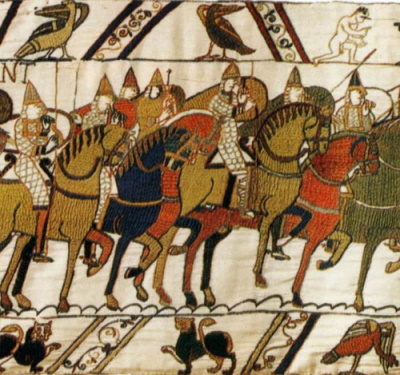Where did the Mortimers come from?
Coutances is a small town on the Atlantic seaboard of Normandy. It is famous for its splendid Norman cathedral, a reminder of the days when it was the religious capital of Normandy. Its bishop, Hugh, was an important political as well as religious leader. Hugh awarded his son Roger (born about 1020) the lordship of a village, Mortemer en Brai, in the east of the duchy – the Pays de Caux. He was also given other lands and received sufficient income to live as a Norman lord.
Roger became one of the many young men whose fortunes were linked with the new Duke of Normandy – William the Bastard. Roger proved his resilience and courage at the battle of Mortemer in 1054 when he and the Count of Eu secured for William a decisive victory over the forces of the French King Henry I. His loyalty was divided, however, for he both captured and released his father-in-law Ralph, Count of Valois. William’s response was swift. Roger was deprived of his centre at Mortemer and only restored to lands at St. Victor en Caux when he had returned to William’s confidence.

In 1066 he fully supported William’s invasion of England by donating ships and sending his eldest son Hugh, who may have died at Hastings. His younger son Ralph came over to England and was soon granted lands in the west of the country, probably as a tenant and supporter of Roger of Montgomery, Earl of Shrewsbury. His father’s appellation of Mortemer, became anglicised into the family name of Mortimer. Roger remained in Normandy and in his old age he built an abbey at St. Victor en Caux, the ruins of which can still be seen. His son Ralph became a Marcher Lord*, the first of a long line of Mortimers based at Wigmore and Ludlow that existed until 1425. Like other Anglo-Norman lords, the Mortimers retained lands in France until the loss of Normandy in the early thirteenth century.
These fiercely independent men exercised a commanding influence on this area of Herefordshire and Shropshire. Though initially they only belonged to the second tier of the Norman elite, their support for the royal cause was often significant, particularly in the time of Simon de Montfort and the Welsh wars of Edward I in the second half of the 13th century. The study of this family gives us a ready insight into the medieval history of England and Wales, and the operation of feudalism.
* See the next article – ‘The Welsh Marches and the Marcher Lords’.